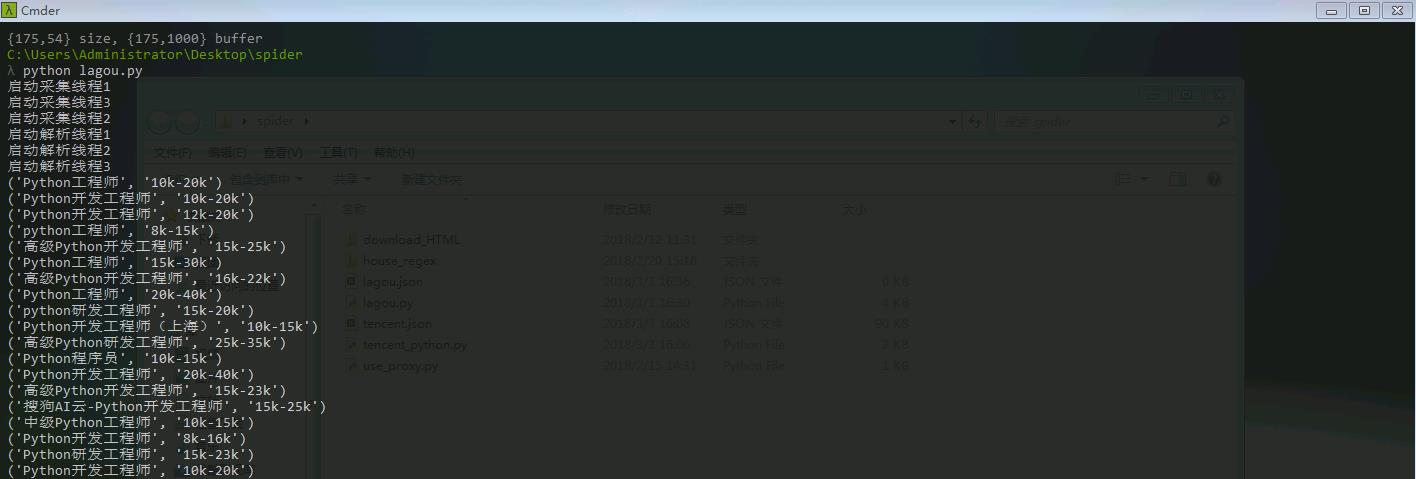线程和进程——python的多线程
Posted CCColby
tags:
篇首语:本文由小常识网(cha138.com)小编为大家整理,主要介绍了线程和进程——python的多线程相关的知识,希望对你有一定的参考价值。
首先要分清楚这两个概念。
进程:一个具有独立功能的程序关于某个数据集合的一次运行活动。其一,它是一个实体;其二,是一个“执行中的程序”。
线程:进程里包含的执行单元叫线程,一个进程可以包含多个线程。它是cpu的基本调度单位。
一个进程的内存空间是可以被它的线程共享的,但是一个线程在使用时,其它线程必须等待。通过“锁”防止多个线程同时占用空间。
在不同线程同时访问时,数据的保护机制是怎样的呢?这就要提到python的一个“锁”——GIL(全称为全局解释器锁),要想利用多核系统,Python必须支持多线程运行。作为解释型语言,Python的解释器必须做到既安全又高效。我们都知道多线程编程会遇到的问题。解释器要留意的是避免在不同的线程操作内部共享的数据。同时它还要保证在管理用户线程时保证总是有最大化的计算资源。所以python就有了这么一个“锁”。这是一个让人头疼的问题,“锁”的存在解决了那一些麻烦,但是也牺牲了python的多线程能力。
python的多线程适合于:大量密集的I/O处理
python的多进程:大量的密集并行计算
尽管python的多线程功能看起来比较鸡肋,但是在爬虫中的应用,还是可以提高效率的。
1 import requests 2 import threading #使用线程库 3 from queue import Queue 4 from lxml import etree 5 import json 6 import time 7 8 9 class ThreadCrawl(threading.Thread): 10 def __init__(self,threadName,pageQueue,dataQueue): 11 12 threading.Thread.__init__(self) 13 #调用父类初始化方法 14 #super(ThreadCrawl,self).__init__() 15 self.threadName=threadName 16 self.pageQueue=pageQueue 17 self.dataQueue=dataQueue 18 self.headers={"User-Agent":"Mozilla/5.0(Macintosh;IntelMacOSX10_7_0)AppleWebKit/535.11(KHTML,likeGecko)Chrome/17.0.963.56Safari/535.11"} 19 20 21 def run(self): 22 pass 23 self.dataQueue.put(content) 24 25 except: 26 pass 27 print("结束" + self.threadName) 28 29 class ThreadParse(threading.Thread): 30 def __init__(self,threadName,dataQueue,filename,lock): 31 super(ThreadParse,self).__init__() 32 self.threadName=threadName 33 self.dataQueue=dataQueue 34 self.filename=filename 35 self.lock=lock 36 37 38 def run(self): 39 pass 40 41 def parse(self,html): 42 pass 43 with self.lock: 44 self.filename.write(json.dumps(items,ensure_ascii=False).encoding("utf-8") + "\\n") 45 46 47 48 49 grasp_exit=False 50 parse_exit=False 51 52 53 54 def main(): 55 #设置页码队列 56 pageQueue=Queue(20) 57 #放入1-10个数字,按照队列的先进先出原则 58 for i in range(1,21): 59 pageQueue.put(i) 60 61 #采集结果的队列,为空则表示无限制 62 dataQueue=Queue() 63 64 filename=open("lagou.json","a") 65 66 #创建锁 67 lock=threading.Lock() 68 69 70 #采集线程 71 graspList=["采集线程1","采集线程2","采集线程3"] 72 #存储线程 73 threadcrawl=[] 74 for threadName in graspList: 75 thread=ThreadCrawl(threadName,pageQueue,dataQueue) 76 thread.start() 77 threadcrawl.append(thread) 78 79 #解析线程 80 parseList=["解析线程1","解析线程2","解析线程3"] 81 #存储线程 82 threadparse=[] 83 for threadName in parseList: 84 thread=ThreadParse(threadName,dataQueue,filename,lock) 85 thread.start() 86 threadparse.append(thread) 87 88 while not pageQueue.empty(): 89 pass 90 91 92 global grasp_exit 93 grasp_exit=True 94 95 print("队列为空") 96 97 98 for thread in threadcrawl: 99 thread.join() 100 101 while not dataQueue.empty(): 102 pass 103 104 global parse_exit 105 parse_exit=True 106 107 for thread in threadparse: 108 thread.join() 109 with lock: 110 filename.close() 111 if __name__=="__main__": 112 main()
上面是以拉勾网为例,写了一个多线程。代码不全,完整代码参考我的github。效果如下:

多线程能提高的效率是有限的,后期会使用异步网络框架如scrapy来提高爬虫效率。
以上是关于线程和进程——python的多线程的主要内容,如果未能解决你的问题,请参考以下文章